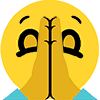Watch
Events
Articles
Market
More
Small Straws by Marsha Burns
When you are feeling lost and discombobulated, stop and take the time to get reoriented. Take inventory of who you are, what you are doing, where you are going, and see that your relationships with others are clear of criticism, judgment or misunderstandings. Let your love shine with a pure heart. 1 Timothy 1:5-6 Now the purpose of the commandment is love from a pure heart, from a good conscience, and from sincere faith, from which some, having strayed, have turned aside to idle talk.



Thought for Today: Shabbat September 09:
Adonai Elohiym’s ultimate desire is to reveal Himself to you; in order for Him te do that - He gives you abundant grace. Our Adonai gives you the experience of enjoying His presence. He touches you and His touch is so delightful that, more than ever, you are drawn inwardly to Him.



HEARING DISORDERS
A healing prayer for someone who suffers from hearing impairments
References:
Isaiah 29:17-19 --- Isaiah 26:3 --- Psalm 107:20 --- Psalm 119:130 --- Matthew 11:5 --- Hebrews 13:8 --- John 10:10 --- John 16:24 --- Exodus 15:26 --- John 15:16
Healing Promise:
[In that day the deaf shall hear the words of the book and the eyes of the blind shall se out of obscurity and out of darkness. The humble also shall increase their joy in the Adonai] -- Isaiah 29:28-29
Healing Prayer:
Abba YHVH, I ask You to hasten the day when the deaf will hear the Words of Your Book, the day when Lebanon shall be turned into a fruitful field and the fruitful field be esteemed as a forest. Thank You for Your promise to keep me in perfect peace as I keep my mind stayed on You Abba. I will trust in You forever, for in You I find both healing and strength. Send Your Word and heal me I ask. Your testimonies are wonderful; therefore, my soul will keep them. When Your Words enter my being, they give me light and understanding and they bring healing to me. When Yeshua walked the earth, He performed many miracles. He healed the blind so that they could see and He healed the deaf so that they could hear. He is my Adonai and Saviour and He is my Great Physician and I truly believe He is able and willing to heal me of my hearing disorder. Yeshua is the same yesterday, today and forever. Thank You for the healing touch in my life my YHVH. In the Name of Yeshua Moshiach therefore, I come against the attempts of the devil to cause me harm. I recognize him as a thief who has come to steal, to kill and to destroy. How thankful I am for Yeshua who has come to give me life, so that I could have it even more abundantly. I claim this promise now, as I seek Your healing power my Adonai and I ask You to give me the abundance of perfect hearing now. I joyfully receive my healing from You now as I pray. Abba, for You are the Adonai Who heals me. Thank You for Your healing love in my life. Thank You for hearing and healing me. In Yeshua’ Glorious Name I pray, amen.


